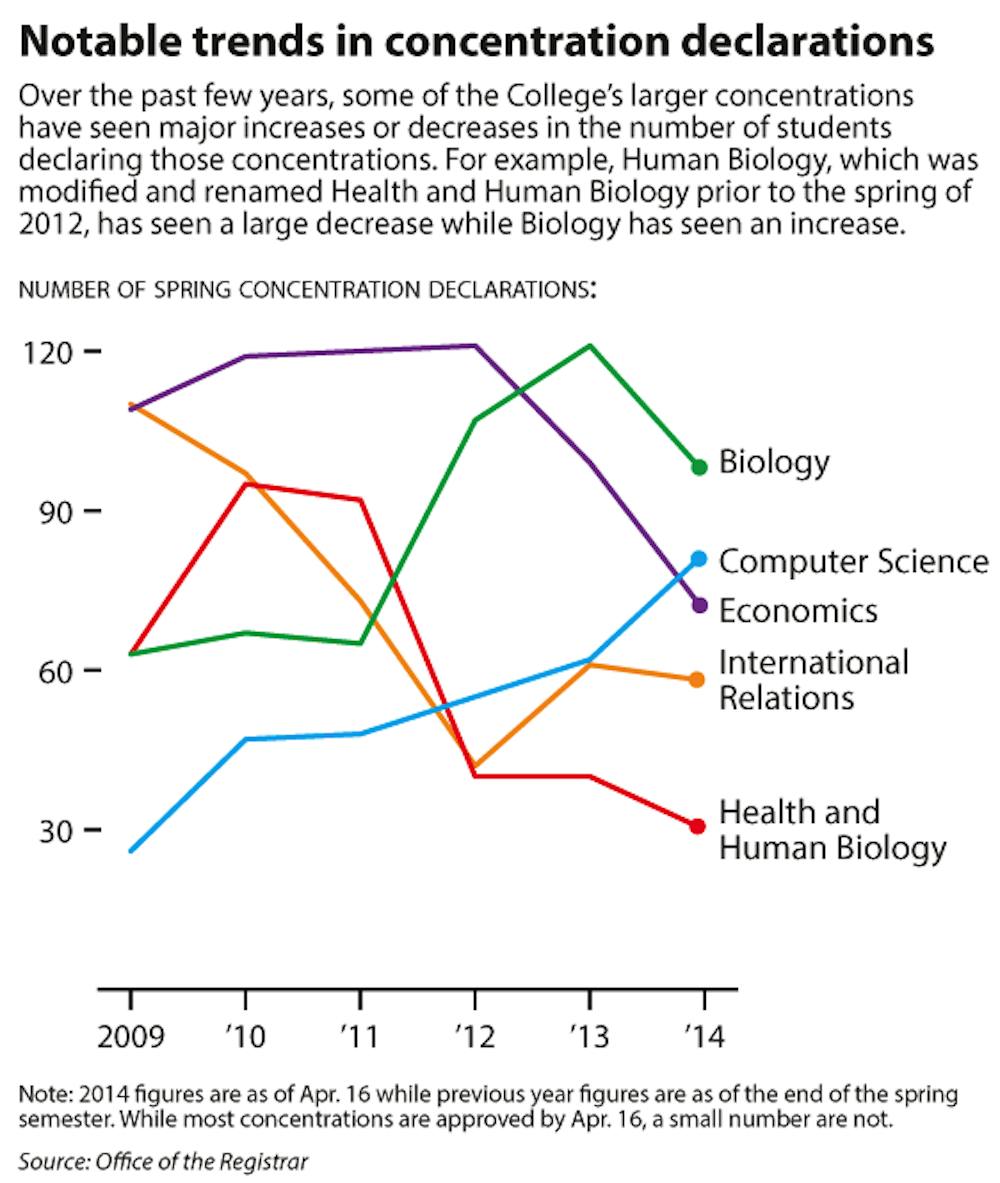Biology topped the list of most popular concentration declarations — submitted by sophomores April 1 — for the second consecutive year, while computer science displaced economics, which witnessed a significant drop in declarations, for second place in this year’s declaration process.
With 97 total declarations as of earlier this month, biology took the top spot, according to sophomore declaration data provided by the Office of the Registrar. Computer science was the second-most declared at 82, continuing its decade-long upward trend. The number of sophomores declaring computer science has more than quadrupled since spring 2005, when just 19 sophomores did so.
Economics was once again among the most popular concentrations, but counted 30 fewer declarations than last spring.
Faculty members cautioned that sophomores continue to add or switch declarations through their spring semester.
“Computer science seemed intriguing, so I decided to continue on with it and realized how powerful it could be,” said Arun Varma ’16, a newly declared applied math-computer science concentrator who said he had considered engineering before discovering his passion for computer science. The availability of jobs after graduation was likely a factor in the increasing popularity of the concentration, Varma said, adding that popular media portrayals of tech-centered characters, like Mark Zuckerberg in “The Social Network” and the character Q in “Skyfall,” have challenged the program’s stereotype as a “geeky” subject.
Roberto Tamassia, professor of computer science and chair of the department, said he does not see the rise in the concentration’s popularity slowing down any time soon. “Computing is the future, and new discoveries in computing are what will create economic growth and prosperity,” he said.
Tamassia expressed concerns that the increased number of concentrators has placed a strain on the department’s resources, saying that he looks forward to receiving additional support from the University as President Christina Paxson’s strategic plan is implemented. In the meantime, “we are experiencing a major crisis as resources we get from the University have remained flat or declining while enrollments have exploded,” he said.
Economics, which has been one of the most popular concentrations in recent years, witnessed a 28 percent decrease in declarations from last year and a 41 percent drop from 2012. The department recently added two additional curricular requirements stipulating that concentrators in the class of 2016 or later must take two econometrics courses, rather than one, and must take MATH 0100: “Introductory Calculus, Part II” or a higher-level calculus course.
But Roberto Serrano, professor of economics and chair of the department, said decreasing the number of concentrators was not an objective of the curricular revisions. “The change was motivated because economics is a very rigorous and quantitative discipline, and we felt that we had to do something about making an undergraduate curriculum more like economics is today,” Serrano said, adding that the curriculum is now more in line with other universities’ requirements.
“We don’t want to be the department with the highest number of students because we are very aware of the strain that puts on the resources that we have,” Serrano said. “The emphasis in recent years has been to create a better learning environment for our concentrators.”
At 78 declarations, business, entrepreneurship and organizations was the third-most popular declared concentration for the second consecutive year.
Rounding out the top five declared concentrations was political science, which had 63 declarations, an increase of 16 over last year’s total.
Vanshika Goenka ’16 said the curriculum and faculty played a primary role in her decision to concentrate in political science.
“There aren’t as many requirements, which allows you to take other classes at the same time you fulfill your political science requirements,” Goenka said, adding that similar concentrations like international relations can have burdensome course loads that limit exploration of other academic interests and can make it difficult to focus on a thesis.
English experienced a notable decline in declarations, falling to 23 from 39 last year.
History has decreased from a recent high of 88 declarations in 2005 to 43 declarations as of this year’s April 1 deadline.
While Department of English faculty members declined to comment on the concentration’s recent trend, Cynthia Brokaw, professor of history and chair of the department, said she hoped her department’s downward trend is leveling off based on an increased number of declarations in 2013 as compared to 2012 and a large number of overall students enrolled in history courses.
“What’s been happening at Brown is a national problem, and I’m cautiously hopeful that we’re turning a corner,” Brokaw said.
“In the wake of the recession, people are more and more concerned about majoring in courses that appear to be giving them an economic advantage,” she said, citing such concerns as a possible explanation for the recent dip in history concentrations.
Neuroscience also experienced a decrease in declarations, declining from 76 last year to 57 this year. The concentration had the fourth-highest total last year, but fell off the top-five list for sophomore declarations this spring.
Ayumi Tsuda ’16 said she chose the concentration in order to prepare for medical school and because she found the material interesting. “I think the decrease in popularity can be attributed to the increasing interest in concentrations like computer science that are perceived as very employable by students right now,” Tsuda said.

ADVERTISEMENT




